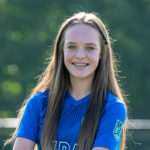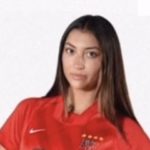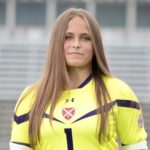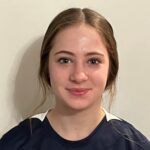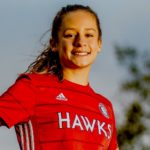PWSI product Annah Lindberg goes her own route in rise to success
 So, if your kid isn’t a star by, say, third grade should you give up? If she doesn’t dominate play by sixth grade? If she isn’t attracting college coach’s calls by eighth grade? When should you worry?
So, if your kid isn’t a star by, say, third grade should you give up? If she doesn’t dominate play by sixth grade? If she isn’t attracting college coach’s calls by eighth grade? When should you worry?
This is the thinking that drives the panic that our kids won’t “make it” in youth sports today. This seems particularly prevalent in the soccer world, perhaps because we hear stories of the early recruits, the young phenoms, the over-achievers. Stories like Frankie Tagliaferri’s, a young woman identified early and whose star is still on the rise. If this worry describes you, then you probably didn’t appreciate me touting her ‘playing up’ success. But talking to her – not her coaches or her parents or her friends – will convince you that she has enjoyed the process and continues to thrive. Oh, and she tells me she’s also stayed almost completely injury free.
Healthy and growing, the two most important words in a parent’s vocabulary. ‘Failure to thrive’ are the three words parents fear above all others. If we make decisions based on this simple standard, we’ll be fine.
+READ: A higher purpose than winning: How to measure player development without the final score
What’s tricky is when we get out the growth chart and look at the percentiles. That gives us good information compared to national averages. Most kids are pretty near the mean, by definition, but in America we tend not to be satisfied with average. We want above average children. Generally, we take one of these approaches to this:
- Ride herd over them to be sure no homework assignment is left behind (aka helicopter)
- Do their homework for them (aka combat helicopter)
- Make excuses for them with the teacher/principal/counselor/coach (aka run interference)
- Put them with a slower group so their average is above average (aka kindergarten red-shirting)
We rarely put them with a more advanced group to offer additional challenge because few will thrive there. Almost none will shine there. Some might benefit from taking a class or two with the advanced group because they have a particular aptitude that qualifies them. That’s where training up, rather than playing up or competing up, is a good strategy,* to try on the bigger size.
The risk we run when we move them up to play with older kids – or if they’re girls, to play with or against the boys – is that we have a whole new curve to measure them by. Is this good for them?
+READ: SoccerWire Q&A: Ohio Premier coach Mike Lawrence and striker Emmanuel Dapaa
Personal aside: My girls teams always played better against same-aged boys teams. In fact, my oldest daughter was quite possibly personally responsible for one young man’s quitting the sport altogether; he started running cross-country, set state records and landed a track scholarship to a very prestigious university. (We’re all good, aren’t we Joe?)
We must ask: are they healthy and growing?
Annah Lindberg comes from a family who chose not to follow the ‘playing up’ path. “She never needed it,” her mother says in an email. “She was perfectly matched for her coach and team.” Her parents didn’t want to “force her into higher competition until her body was ready.”
 Annah’s rise through the youth soccer ranks is nearly unique in that she stayed with the same PWSI team as team captain from 2007-2013. With so many options in the Northern Virginia area, it is easy to look around for a better group of players that might offer a bit more exposure to college-coaching eyes. Instead, Annah developed her own training regimen. She would head to the field on her own and practice. As she showed increased interest, her parents employed local training experts or college kids to supplement training. As Annah grew in the game, she wanted to try to make the State and then Regional ODP teams. She did, to good effect, and with good reviews.
Annah’s rise through the youth soccer ranks is nearly unique in that she stayed with the same PWSI team as team captain from 2007-2013. With so many options in the Northern Virginia area, it is easy to look around for a better group of players that might offer a bit more exposure to college-coaching eyes. Instead, Annah developed her own training regimen. She would head to the field on her own and practice. As she showed increased interest, her parents employed local training experts or college kids to supplement training. As Annah grew in the game, she wanted to try to make the State and then Regional ODP teams. She did, to good effect, and with good reviews.
But she didn’t get the National team call up that Tagliaferri did. Do you think she could have progressed more fully or more quickly if she had played among a stronger group of kids? I asked her mother, Amy.
“Possibly, but that wasn’t the goal. We didn’t want to rush it and wanted her to ease into her zone, on her own time.”
+READ: LeBolt: The feeble, sickening art of flopping is getting out of hand
Annah really didn’t show potential to shine in soccer until the eighth grade, according to Amy. As a ninth grader, poised to star on the high school team, there was plenty of opportunity. And she rose to the occasion, kind of like a kid who has been holding back until just the right moment. In high school she was AAA All State first team, NW Region first team and player of the year, All Met first team and All Met goal leader with 27 goals and 9 assists. She was her high school’s female athlete of the year as a sophomore. High school had forced her to ‘play up’ and she had risen to the occasion, athletically. 
But high school and the older kids present other challenges to young players: older kids who hang with even older kids. I remember the phone call I received from a fellow mother when my oldest was a new freshman on the high school team. That mother showed me the ropes: don’t let your daughter ride with these kids, don’t let her go to a sleepover at this house, watch out for signs of a, b and c. That mother knew what she was talking about. She and I are still close friends.
Annah had dreams of Division I college play and her star was still on the rise. Looking back, the Lindbergs realize they sacrificed much to help their daughter get these opportunities. Mrs. Lindberg admits she even “harbored some resentment with the overzealousness it required especially with school, club and ODP overlap. It was getting nutty and seemed obsessive.” Anyone?
Amy elaborates. Annah “would like to get a look by the National talent pool; she had very good reviews from State and Regional coaches. It seemed she might have an opportunity but we weren’t chasing that dream, sending her to every international event in the hopes that someone might see her,” her mom writes. “For two years her ankles were keeping her from peak performance. Then at Regionals – the last year – she was 100 percent and did exceptionally well. She was invited abroad but we declined. In this we may have thwarted her visibility but at the same time, she needed to stay on task for SAT courses, exams and keep her academics in place (A/B student). It seemed extreme to go to Russia (her junior year, missing three weeks of school). Her closest teammates from Region I did get attention, so in hindsight, it left us feeling like we may have ducked a chance at her getting ‘seen.’”
Which begs the question: what is healthy and what are we growing into? These kids are not just bodies; they are hearts and minds and souls. If a playing environment or a school environment or a social environment is not healthy, it’s always a poor choice.
The Lindbergs found a new path. Annah studied and played her senior year at the IMG Academy in Florida. She loved to train and was dedicated to working hard, so the “prep school” environment seemed a good fit for her. At first, a bit reluctant to leave the PWSI club and team and her school and neighborhood, Annah made the switch and thrived. From her player profile:
IMG ACADEMY 2013-2014
Disney Showcase Champions
Team ranked #1 in Florida and #1 in Region III
CASL Champions U 18/19
Amy said that having IMG as an “out” was a blessing. They consolidated everything and “normalized” their lifestyle. There’s a lot of health in that.
“Annah wants to play D1 at NC State and turn the team up several notches,” Amy said. “They do not have a strong history of success and she wants to form the core of a new legacy there. She wants to contribute.”
Sounds very Lindberg to me. Her family holds loyalty and leadership as highest ideals. Amy is US Navy Captain, retired. Father Brad, is a Colonel USMC, and brother Bradley is a captain in the USMC. Annah is interested in becoming a PT in the Navy.
But Amy says honestly, “If Annah were recognized and invited to ONE NATIONAL TEAM CAMP, I think she’d be even more satisfied. She wants ONE INVITATION. Just ONCE.”
Parenting is terminal. We all want above average kids. Way above average.
*Academy coaches…this situation needs to be better communicated. Parents are watching who “gets asked” and asking “why isn’t my kid the one being asked?” General communication about your approach and full disclosure about which kids and which teams and why has been a subject mentioned to me as needing some attention.
SOCCERWIRE MARKETPLACE
- The St. James FC Virginia 2024-2025 Travel Tryouts
- TSJFCV - Hiring Travel Soccer Coaches
- Hiring: U13-U19 Boys Director
- Coaches Needed
- Train with professional AC Milan coach
- Loudoun Soccer 2024/25 Travel Player Placement Sessions
- Official Elite Summer Soccer Camps with Elite Pro Clubs in Europe
- Official EPL Tickets: ARSENAL, LIVERPOOL, TOTTENHAM & MORE
- Travel to Denmark for Dana Cup Hjørring 2024
- New England Surf Challenge and Showcase 2024

